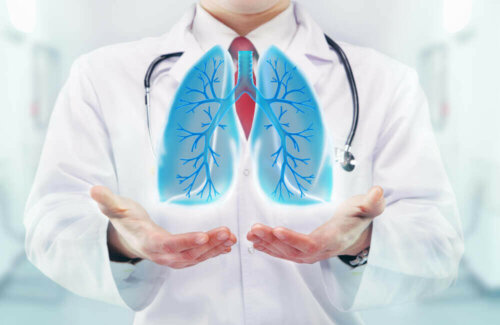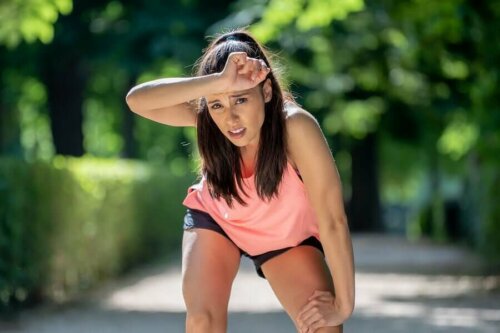Why is it Hard To Breathe when I Do Exercise?


Written and verified by the doctor Leonardo Biolatto
More and more people are becoming aware that physical activity is a fundamental part of having a healthy lifestyle. However, not doing it too often or exercising incorrectly can make it hard to breathe while exercising.
Difficulty breathing when playing sports can manifest as shortness of breath, cough, narrowing of the throat, or wheezing (whistle-like noise when air passes through your throat). Overall, there are many reasons why breathing problems can develop during physical activity.
In this article, we’ll analyze everything associated with breathing during exercise.
What function does breathing have?
Breathing has several functions. However, the most important is to maintain the functionality of the body by:
- Supplying oxygen to tissues and remove CO2 waste, created by cells.
- Constant maintenance of the blood acidity, which is measured by the pH. The pH has a narrow healthy range between 7.35 and 7.45. Breathing is responsible for keeping the blood in this range by expelling CO2.

Ventilation and breathing
In order to define respiration, you have to understand the concept of ventilation and the types that exist.
On the one hand, we have pulmonary ventilation, which is the process by which air enters and leaves the lungs. This mechanism occurs through the neural activation of the respiratory muscles and the pressure differences between the lungs and the outside air.
On the other hand, all this air that you breathe doesn’t reach the alveoli to produce gas exchange and be able to carry oxygen to the tissues. Instead, it remains in the airways (bronchi, trachea, etc.). This unused air occupies a volume called “anatomical dead space.”
If we subtract the volume of air that enters through pulmonary ventilation, and that of the air from the physiological dead space, it gives rise to the air that actually does reach the alveoli and is used. This volume that reaches the alveoli is part of the alveolar ventilation mechanism.
Therefore, depending on the way you breathe, if you do it deeper or shallower, if it’s hot or cold, or if you’re exercising or not, the amount of air that actually reaches the alveoli can vary.
Types of ventilation
There are two different types of ventilation. However, both are represented by the same variables (with some differences). This is because this process is essentially defined as the volume of air that enters per minute when you breathe. This is found by multiplying these two quantities:
- Respiratory rate: How many times you breathe per minute. On average, a healthy person usually takes 12 breaths per minute at rest.
- Tidal volume: The volume of air that enters in one breath. A healthy person at rest usually gets 0.5L of air per breath.
Therefore, the ventilation of a healthy person is usually about 6 liters per minute.
Keep reading: Why You Need to Get Regular Physical Exercise
Breathing when exercising: What happens?
When exercising, the muscles perform two processes:
- They use the oxygen that comes from the blood to get energy and to be able to move.
- Since they have to work a lot, they also obtain energy from other processes that don’t require oxygen. However, these processes generate lactate, which is released into the blood and acidifies it.
Due to these processes, the blood that circulates through the muscular tissues remains without oxygen and acidified. This can endanger your body. Fortunately, to prevent this from happening, the brain, through receptors that it has distributed throughout the body, becomes aware of these alterations and causes you to:
- Breathe faster by increasing your respiratory rate.
- Breathe much deeper so that more air can enter the lungs for each breath you take. In other words, your tidal volume increases.
Therefore, if your respiratory rate and respiratory volume increases, pulmonary and alveolar ventilation will also increase. Basically, this means:
- More oxygen reaches the blood to meet the needs of the muscles.
- Your body expels more CO2, eliminating the acid generated by muscles, and keeping the pH of the blood stable.

Stages of breathing during exercise
According to studies, researchers have determined that there are three stages when you exercise. In the first and second stages, the ventilation rises abruptly in order to carry out the activity. Upon reaching the third stage, the body adjusts and ventilation remains stable.
You may be interested in: Exercise and Pregnancy: Things to Consider
Why is it hard to breathe when I exercise?
If you’re not used to exercising, at first you might feel suffocated. However, this effect is completely normal. Your respiratory system has to exert itself in order to keep maintain normal blood conditions and keep them from changing in the ways we mentioned.
However, as you continue to exercise, breathing becomes easier, since your body becomes accustomed to the new situation. On the other hand, you should know that it’s doesn’t feel the same when you exercise with the same intensity all the time as when you do an exercise that increases in intensity.
In an exercise that gets more intense over time, your body won’t get used to it and will continue to demand more oxygen. Therefore, you’ll breathe even faster. Of course, you’ll continue to draw in the same volume of air for each breath.
In professional athletes, we can see that their respiratory rate is much lower. This is professional athletes have trained their respiratory system to catch more air. Thus, they breathe more deeply and keep the air much longer in the lungs, thus requiring fewer breaths.
When to see a doctor when it’s hard to breathe during exercise
Difficulty breathing during exercise can indicate that you’re not used to it. However, it’s important to note that it can also be a sign of other respiratory or cardiovascular conditions. Therefore, you should pay attention to symptoms such as:
- Shortness of breath or suffocation, so strong as to keep you from continuing the activity.
- Wheezing or whistling when breathing.
- Dizziness or fainting
- Feeling that your chest is expanding and retracting excessively.
If you experience any of these symptoms, you should go to the doctor to determine if they’re caused by an underlying condition. If so, the professional will direct your treatment depending on the problem.
All cited sources were thoroughly reviewed by our team to ensure their quality, reliability, currency, and validity. The bibliography of this article was considered reliable and of academic or scientific accuracy.
- European Lung Foundation. Los pulmones y el ejercicio.2020 . Disponible en: https://www.europeanlung.org/assets/files/es/publications/lungs-and-exercise-es.pdf
- Wilmore. Fisiología del Deporte y el Ejercicio de W. Larry Kenney | Editorial Médica Panamericana. 2014. Disponible en: https://www.medicapanamericana.com/es/libro/wilmore-fisiologia-del-deporte-y-el-ejercicio?gclid=EAIaIQobChMIos_H_fr56AIV_QYGAB1S1wEAEAEYASABEgIFIvD_BwE
- Brinkman JE, Sharma S. Physiology, Respiratory Drive. [Updated 2020 Mar 25]. In: StatPearls [Internet]. Treasure Island (FL): StatPearls Publishing; 2020 Jan-. Available from: https://www.ncbi.nlm.nih.gov/books/NBK482414/
- Aliverti A. The respiratory muscles during exercise. Breathe (Sheff). 2016;12(2):165‐168. doi:10.1183/20734735.008116
This text is provided for informational purposes only and does not replace consultation with a professional. If in doubt, consult your specialist.








